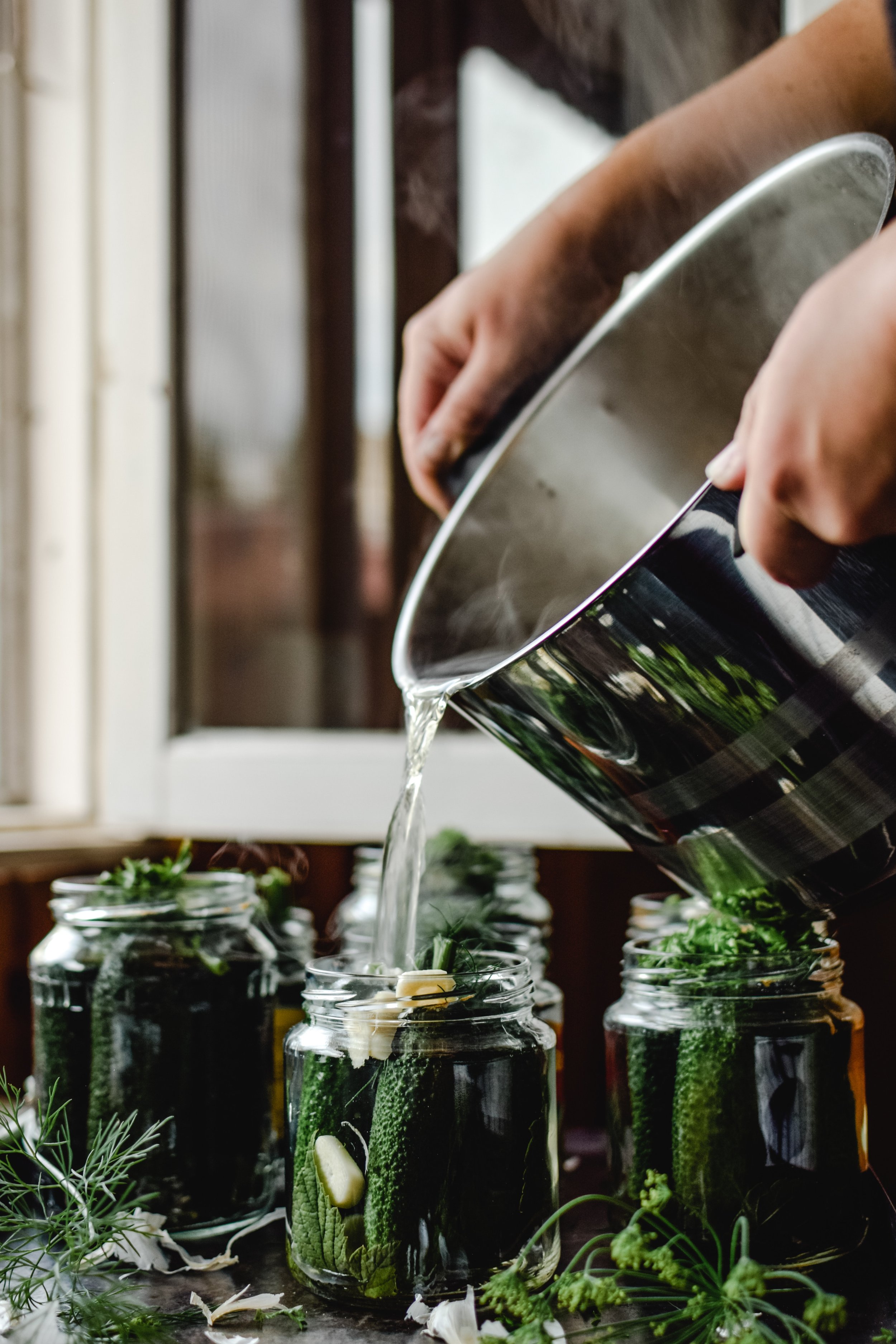The Value of Fermented Foods
solvING contemporary health problems
Hello Palate’s ancestral pantry series continues with a spotlight on fermentation with foods like kimchi, krauts, and kefir yogurt. Check out the “Value of Stocks and Broths” to add to your pantry items. Please leave a comment below and share with our community your thoughts, curiosities, and habits about traditional ways of enjoying and preparing food or anything you want to learn more about.
Strange but Good
Remember when almond milk sounded strange in our coffee mugs?
It may sound like another weird eating habit, but you should consider incorporating lacto-fermented vegetables to complement any meal and reap the healing benefits. Think about how you have felt lately. Are you chronically tired, experiencing seasonal sadness, bloated, and skin looking lackluster – or do you have vague digestive symptoms that annoy you? Wouldn’t it be ideal for eating your way healthy? In time, I hope cultured vegetables become commonplace as kale became in our daily salad bowls.
What is Lacto – Fermentation?
Fermentation is a simple process of preserving food as old as time itself. The alchemy in its preparation is taking humble ingredients like cabbage, sea salt, and a few spices and submerging the vegetable into an anaerobic condition to produce lactic acid. Lactic acid is a natural preservative that inhibits the growth of harmful bacteria, hence giving its unique name “lacto-fermentation.” The magic continues with the proliferation of vitamins and enzyme levels, which make foods easier to digest by breaking down and assimilating nutrients into our bodies. In addition, the lactobacillus organisms present in fermented foods are heavily researched and shown to contribute to good health. *
Our ancestors enjoyed a variety of fermented foods and innately understood their health benefits. Many people today don’t eat nearly as much of them as in past generations, especially the non-pasteurized kind found in homemade jars. The lack of this awareness is, perhaps, the reason why food allergies* to chronic illnesses are more prevalent today than in the days of our great-grandparents.
Furthermore, most fermented vegetables found in western diets are steeped in vinegar (think about your store-bought pickles); even though these vegetables are fermented (broken down, cooked), they do not offer the probiotic and enzymatic value of steeping the vegetables in salt water to create the magic of lactic acid. If you’re in the market, remember to check your labels now that not all pickled foods are fermented, and not all fermented foods are pickled! Riddle that to your friends at your next party! #foodgeek
It’s a Bug Life
If you grew up like most Americans in an age of ultra pasteurization, the sour and spicy sensation found in kimchi, which bursts onto our palates with its live active bugs, might taste funky. We have to embrace the fact that we are not a single organism; more live active bugs live in us, outnumbering our cells by 10 to 1. We are made up of colonies of bacteria that live symbiotically within us, playing a crucial role in our overall health. The emerging scientific research in the gut biome study confirms that Hippocrates nailed it over two thousand years ago “all disease begins in the gut.” Are we finally listening to ancient wisdom?
Gut Microbiota, Probiotics, and the link to our Health
The human gut is the largest mucosal organ, with a complex ecosystem of various microbial communities battling to populate their species. When these lively microbial communities live in harmony with you, their host, they are in constant communication with our cells and are integral to our digestive capacities, immune systems, detoxification systems and our neurological functions;* this translates to everything from making us happier human beings to clearing up acne or fixing autoimmune issues.
At some point in your adult life, you’ve heard about probiotics and their benefits to our health. We know that probiotics are an army of good bacteria, the allied forces. You want to keep their barracks (your gut) well stocked with food (prebiotic) for them to flourish and balance the natural and normal evil armies of bacteria, including yeast, parasites, and viruses, to create a peaceful ecosystem. When the bad army of bugs wins over the good guys, dysbiosis or simply gut imbalance occurs. Any negative consequences in terms of health and disease have been associated with the impairment of our gut biome; it manifests as inflammation in our bodies. Our internal communities need our attention to keep the ecosystem balanced more than ever from threats in our daily lives. They are under assault from repeated antibiotic exposure, diets high in refined carbohydrates and processed oils, chronic stress, and environmental toxicity (pesticides and plastics). Therefore, we all experience some inflammation that can express itself, for example, in minor symptoms like bleeding gums or acne to more severe chronic conditions in autoimmunity and diabetes.
Lacto- Fermentation: Feeding our Microbiome with Care and Attention
Suppose our health depends on the integrity of our gut biome. In that case, the gift of lacto-fermention and its diversity of beneficial bacteria like lactobacilli makes it the ideal example of “food as medicine.” It wasn’t long ago that I set out to see if this briny mix of heath promises could win over the foodie in me.
Let’s face it, we all want to eat healthier but only want to eat foods we enjoy. With Kimchi’s sour and sharp notes, the taste seemed so foreign to my western way of eating. It isn’t the only culinary option for fermented, cultured vegetables. There are endless taste options for every palate. The question is – is it easy to make at home? Most of us may be concerned about producing a jar of foul-smelling mold instead of the healthy probiotic lactobacillus. But the benefits outweigh the concern, and you’ll be surprised by the ease of preparation, and fermented foods are some of the safest foods to eat. It’s a fun kitchen activity for kids to get their hands on. It will not take them long to lick their salty fingers. In doing so, children can develop their palate for healthy ingredients like turmeric, ginger, or garlic in an engaging way. It’s important to introduce their palates to sour and spicy healing probiotics foods, such as fermented veggies, early on, so you can use your kitchen as your pharmacy. A natural way to inoculate their gut biome with beneficial microbes that will boost their immune system.
Convinced? If so, I recommend culturesforhealth.com. It’s a fantastic resource that opened my mind to eating something delicious and cost-effective while reducing my pill-popping days of supplemental probiotics. In some cases, oral supplementation is necessary; however, homemade rules are due to a higher amount of enzymatic activity and live active cultures inherent in homemade alternatives. This site has tutorials and endless easy-to-follow recipes to help you find a palate preference and reap the health benefits. And, of course, check back frequently for Hello Palate’s recipes!
Here are a few other Hello Palate recommendations to get you started:
Explore Recipes Here:
Taste Tasters: easy recipes to amuse your palate
http://www.culturesforhealth.com/learn/recipe/lacto-fermentation-recipes/fruit-kvass/
http://www.culturesforhealth.com/learn/recipe/natural-fermentation/sauerkraut/
Adventurous Palate: exploring traditional cultures without an airline ticket
http://www.culturesforhealth.com/learn/recipe/soy-recipes/kimchi-miso/
The Seasoned Palate: Natto your palate with Vitamin K!
http://www.culturesforhealth.com/learn/recipe/soy/how-to-make-homemade-natto/
A Note on KEFIR yogurt
Kefir is a sour, drinking yogurt; unlike cultured vegetables, kefir requires “grains” to begin the fermentation process. The name is misleading, referring to the grainy texture but not the actual SCOBY. This stands for “Symbiotic Communities of Bacteria and Yeast” that start the fermenting process; milk sugars are broken down, reducing the lactose found in milk. Goat milk kefir makes an even better choice with a further reduction in lactose. Another benefit to fermented dairy is the active lactase enzymes, which make digestion easier for those who otherwise can’t digest dairy. The diary is beneficial only when your gut is healthy and tolerates lactose well.
TASTY benefits:
Digestion is fundamental to nutritional therapy. Without proper functions, it is the root of all diseases. Lacto-fermented foods alleviate the burden on our digestive system, essentially doing the work for you through enzymatic activity, assisting other foods paired with it to digest and assimilate nutrients properly.
Fermented vegetables increase the bioavailability of elusive vitamins and minerals, with a boost in B vitamins, zinc, and magnesium. Vitamin C is also enhanced in the process. Zinc is a mineral that helps increase your stomach acids, which is a good thing; it relates to better digestion.
If you constantly crave sugar, chances are the nasty bugs are controlling your appetite for sweets. If you consistently feed them cake and cookies, your intestines become a five-star hotel, creating the ideal environment for yeast and pathogenic bacteria to take over. Remember, fermented foods will help control your sugar cravings by supporting the good guys in your gut – giving them the correct information to win and make you feel like a superstar!


